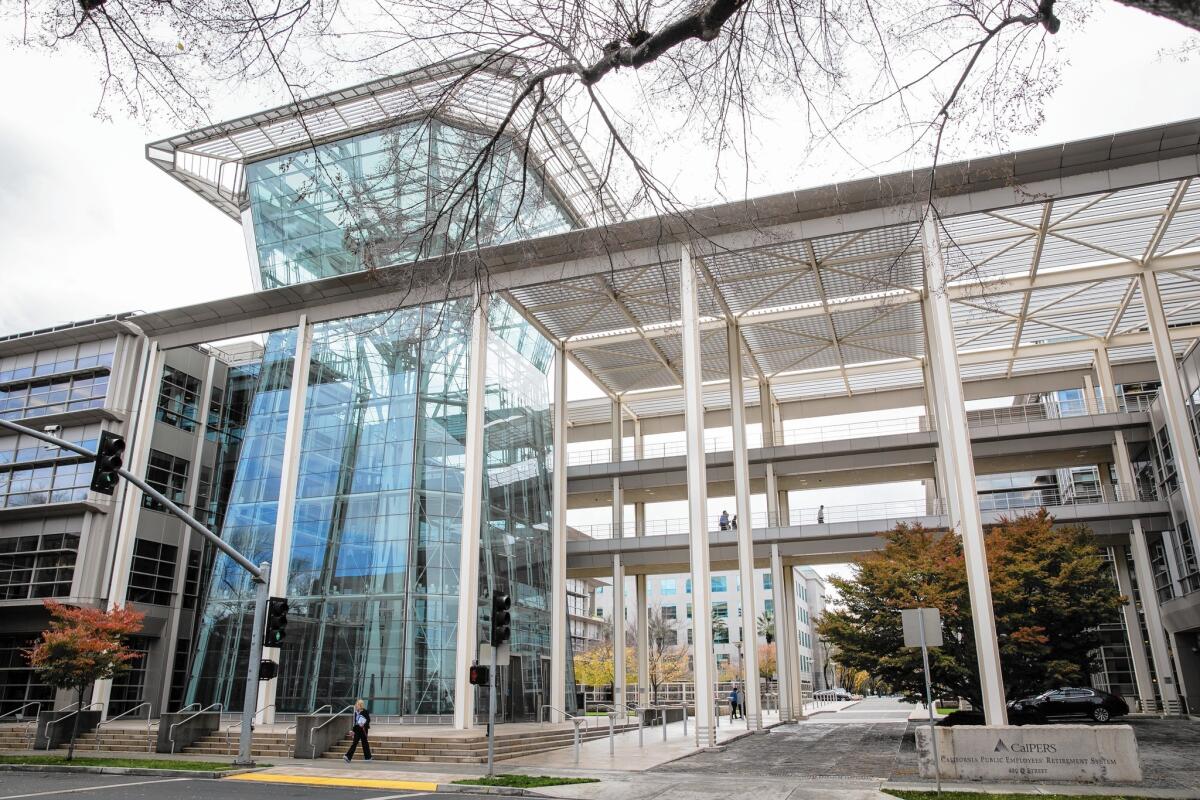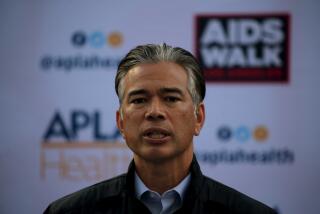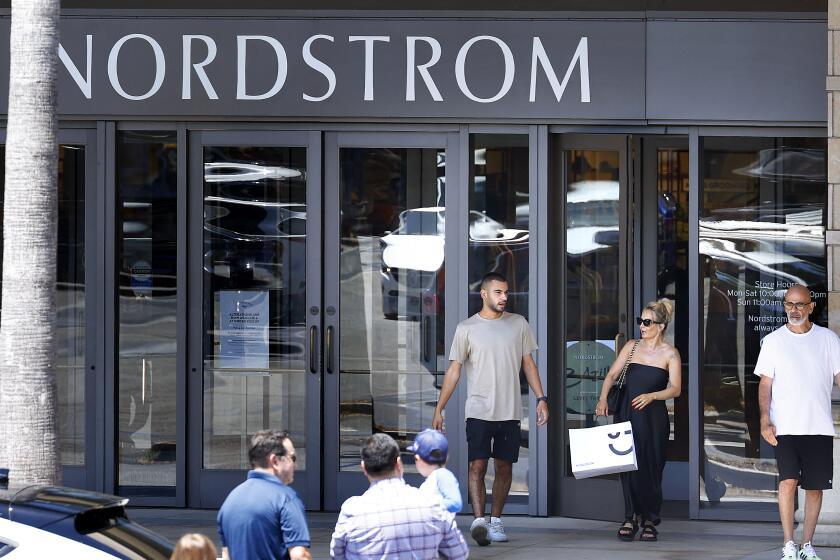CalPERS’ private equity investing fees are expected to be ‘ginormous’

- Share via
CalPERS is finally about to reveal how much it really pays Wall Street for its most rarefied services — and taxpayers can expect a dose of sticker shock.
Last month, the California Public Employees’ Retirement System announced with some fanfare that it would disclose the full amount it pays for private equity investing, the high-stakes, high-reward business of buying and selling whole companies dominated by massive global players such as Carlyle Group, Kohlberg Kravis & Roberts and Blackstone Group.
At issue are the performance bonuses, known as carried interest, which for decades have been collected by Wall Street giants as part of their compensation, but have not been disclosed by pension funds to the public. Typically, the bonuses are 20% of profits over a certain target that come on top of a 2% management fee, a formula known as 2-and-20.
SIGN UP for the free California Inc. business newsletter >>
Private equity observers say the figure will be big, and its release could usher in a new era of greater disclosure and more public pressure to lower fees.
“All pension funds are going to be embarrassed when they have to reveal just how much they are actually paying private equity in performance fees,” said Eileen Appelbaum, senior economist at the Center for Economic and Policy Research, a Washington think tank, and author of “Private Equity at Work: When Wall Street Manages Main Street.”
“And once CalPERS publishes what it has paid, it will be difficult for CalSTRS (California State Teachers’ Retirement System) and other pension funds to refuse to do so. The amounts are going to be ginormous, and public officials are going to ask whether these payments ... are warranted.”
Wylie A. Tollette, CalPERS’ chief operating investment officer, said CalPERS plans to disclose the grand total of carried interest it has paid out from funds operating since 1998, and “it’s going to be in the billions.”
“It’s a dilemma,” he added. “You don’t want it to be astronomically high because that represents profits that you wanted to grab for yourself.” But he said CalPERS needs the high returns private equity traditionally has provided, and the fee figure represents the going rate.
The stakes are large. Like other pension funds, CalPERS relies on private equity to meet its ambitious annual return target of 7.5% and keep pace with ever-growing obligations to its 1.7 million current and future retirees. When investment returns fall short, the system turns to taxpayers to make up the shortfall — a challenge for communities struggling with retirement costs they say are already unsustainable.
For the year that ended June 30, for instance, CalPERS’ $28.9-billion private equity portfolio handily beat stocks and bonds with a return of 8.9% — and that was a down year — while CalPERS’ massive $162.6-billion in stock holdings returned just 1%. Private equity represents about 10% of CalPERS’ $302-billion total fund.
Those kinds of outsized returns have helped insulate the private equity industry from a chorus of criticism for its high costs, complexity and murky disclosure.
The issue flared up at a CalPERS investment board meeting in April when, under questioning from board member J.J. Jelincic, Tollette couldn’t provide a figure and acknowledged that the fees were “not explicitly disclosed or accounted for. We can’t track it today.” Although CalPERS’ pending disclosure is intended to quiet critics, some aren’t impressed.
“It’s about time,” Jelincic said in an interview. “I knew we weren’t disclosing it. I was shocked to find out we weren’t even tracking it. It’s obviously good to know what the hell we’re paying.”
Others say CalPERS deserves credit for disclosing carried interest costs, even if belatedly, when most pension funds still don’t. The South Carolina Retirement System Investment Commission, a fee-transparency pioneer, began disclosing full private equity costs, including carried interest, two years ago — and received furious criticism when the actual cost — at least 3.2% of private equity assets –- was finally revealed.
“It’s been lonely out here for a while,” said Michael Hitchcock, the system’s executive director. “But at the end of the day, it’s the right thing to do and it’s where the industry is moving.”
Whether other funds will follow CalPERS is an open question.
Margot Wirth, director of CalSTRS’ private equity portfolio, said the issue “will be discussed at the investment board level in the coming months.”
Private equity defenders say the carried interest issue has been wildly misunderstood and that what critics call a “fee” is actually just a share of profits taken out by private equity firms before delivering investors’ share, known as the “net return.” As such, it doesn’t need to be reported as a pension fund expense. What’s more, they say, carried interest costs have always been available to investors in audited financial statements, even if not always in a uniform format.
“Private equity is not at all mysterious to the investors,” said James Maloney, spokesman for the Private Equity Growth Capital Council, a Washington trade group. “In fact, limited partners have shaped the development of the asset class, and private equity has generated superior returns to limited partners over many years.”
CalPERS’ Tollette said calculating the carried interest has been complicated because the data are buried, in different formats, on annual financial statements of more than 700 limited partnerships dating back more than a decade. The task required creating standardized reporting and accounting systems and took three years.
The tab is likely to be high, even by Wall Street standards. CalPERS paid private equity $439 million in base management fees to manage $31.5 billion for the year that ended June 30, 2014, or about 1.4% of assets. By contrast, it paid less than 1%, including both base and performance fees, or about $148.6 million, to manage the fund’s huge public stock portfolio, then $158.1 billion, about five times as big.
A study published in April by CEM Benchmarking Inc., a Toronto pension advisory firm, found that less than half of pension funds’ actual private equity costs are disclosed to the public. CEM said that although reported management fees average 1.8% of assets, performance fees add an additional 1.49%, on average. For CalPERS’, that suggests it paid more than $400 million in performance fees and — conservatively — more than $800 million total, for the year that ended June 30.
And that is for a private equity portfolio that has long underperformed its target. CalPERS’ 8.9% return in fiscal 2015 was actually 2.2 percentage points below its benchmark, continuing a string of below-benchmark performances for the one, three, five and 10 years that ended June 30, 2014.
But since performance bonuses are tied not to the benchmark but to a specific target (usually 8%), private equity firms will be in line for performance bonuses anyway, analysts said.
Tollette said the underperformance is mostly the result of flaws in private equity benchmarks, and that CalPERS is satisfied with its portfolio’s performance.
Private equity advocates say that given the sector’s strong returns, even after carried interest is deducted, the issue is more symbolic than real. But critics say the industry’s fee structure stems from a legacy of agreements reached decades ago and is irrelevant to an increasingly fee-conscious environment.
“Wouldn’t paying 10% of the private equity profits still give the PE firm better returns when the fund was more profitable?” said the Center for Economic and Policy Research’s Appelbaum.
“And it would leave a lot more of the profit ... to be distributed to pensioners. What’s the magic in 20% of profits? And shouldn’t there be a benchmark that the fund has to beat before the PE firm collects carried interest? Or do we simply reward them because the stock market rose to new highs, and they cashed in by selling portfolio companies?”
CalPERS is expected to release the final totals this fall.
ALSO:
Consumer spending growth cools despite solid rise in personal incomes
Private equity industry sees more federal regulation
Special Report: As a deadly superbug spread, UCLA doctors raced to find the source
More to Read
Inside the business of entertainment
The Wide Shot brings you news, analysis and insights on everything from streaming wars to production — and what it all means for the future.
You may occasionally receive promotional content from the Los Angeles Times.











